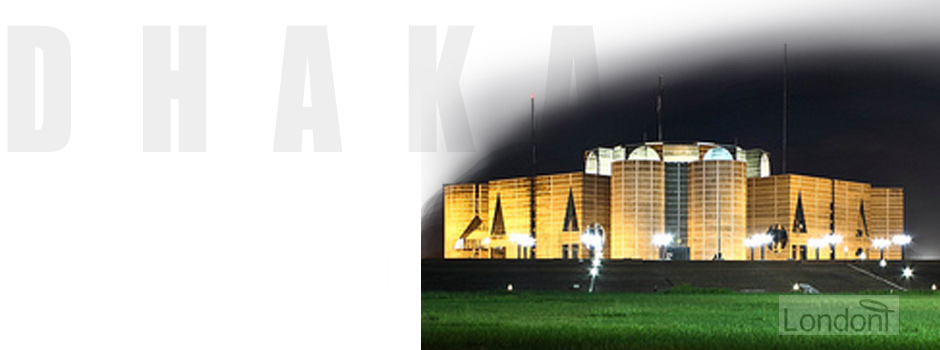
Photos are taken from various sites across the internet. Full copyright of these beautiful photos belong to the original photographers - please seek their permission before using them. Jazzakallah'khair / Dhonnobad / Thank you for letting us use them here.
Map of Dhaka
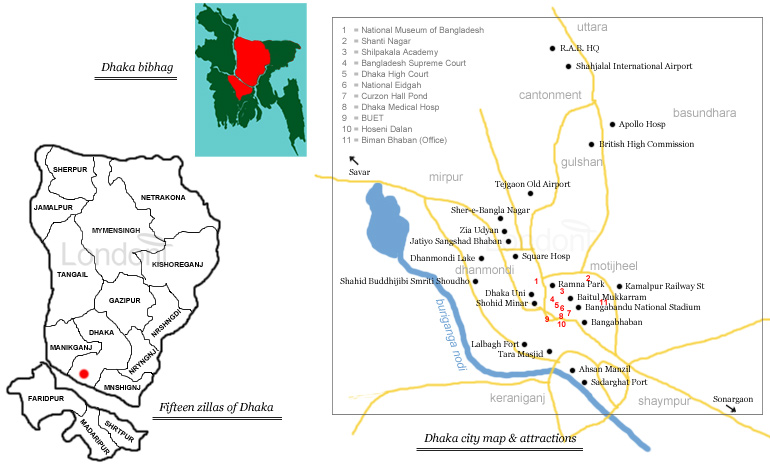
Dhaka from the air!
-
7th - 16th century: Buddhist Kamarupa to Hindu Sena Dynasty to Sultanate of Bengal
The existence of urbanised settlements in the area that is now Dhaka city dates from the 7th century. The present day Savar was the capital of the Sanbagh Kingdom during seventh and eighth century. The city area of Dhaka was ruled by the Buddhist kingdom of Kamarupa (first historical kingdom in Assam, covering the entire Brahmaputra river valley, North Bengal and parts of Bangladesh) and the Pala Empire before passing to the control of the Hindu Sena dynasty in the 9th century.
The Sena dynasty were called Brahma-Kshatriyas i.e. those who were Brahmanas first and became Kshatriyas afterwards, as evidenced through their surname which is derived from the Sanskrit for "army".
Origin of the name 'Dhaka'
There's no historical clarity regarding the origin of the name of Dhaka. Many Hindus believe it is derived after the establishment of the Goddess Dhakeshwari's temple by Ballal Sena in the 12th century. Dhaka and its surrounding area was identified as Bengalla around that period. The town itself consisted of a few market centers like Lakshmi Bazar, Shankhari Bazar, Tanti Bazar, Patuatuli, Kumartuli, Bania Nagar and Goal Nagar.
Other suggestions put forward about the origin are:
- The name is derived from the Dak tree (Butea frondosa) which was once found in the place in abundance.
- The Hindu Goddess Durga, found concealed (dhaka-Ishvari or concealed goddess) in the place.
- The dhak or drum beaten by order of islam khan while inaugurating the capital.
- A Prakrt dialect called Dhaka Bhasa.
- Dhakka used in the Rajtarangini for a watch-station.
- It's the same as Davaka, mentioned in the Allahabad pillar inscription of Samudra Gupta as an eastern frontier kingdom.
Sultans take over
After the Sena Empire, Dhaka was successively ruled by the Sultanate of Bengal, a state that existed from the 14th through the 16th centuries which was eventually absorbed into the Mughal Empire. In 1342, a local warlord, Shamsuddin Ilyas Shah proclaimed himself as monarch of the Kingdom of Lakhnauti. He would go on to consolidate his rule by conquering the other independent kingdoms of Bengal before proclaiming himself as Sultan of Bengal in 1352.
The absorption of Bengal into the Mughal Empire was a gradual process beginning with the defeat of Bengali forces under Sultan Nasiruddin Nasrat Shah by Babur at the battle of Ghaghra.
In addition to the governance by the Sultanate of Bengal, Dhaka was successively ruled by interruption of Turkish and Afghan governors descending from the Delhi Sultanate (a term used to cover five short-lived Islamic kingdoms or sultanates in medieval India) before the arrival of the Mughals in 1610.
1610: Jahangir's Mughals come to town
Mughal empire ruled a large portion of the Indian subcontinent extending from Bengal in the east to Balochistan in the west, Kashmir in the north to the Kaveri basin in the south from 1526 to mid-19th century. The emperors were descendants of the Timurids, a dynasty of Turco-Mongol ancestry.
Capital of Bengal
In 1610 Mughal subahdar Islam Khan Chishti transferred the capital of Subah Bangla from Rajmahal to Dhaka. Dhaka now became capital of the subah (province) of Bengal, Bihar and Orissa and Islam Khan Chishti became the first administrator of the city. Islam Khan renamed the town "Jahangir Nagar" (City of Jahangir) in honor of the Mughal emperor Nur-ud-din Salim Jahangir, popularly known as Emperor Jahangir. The city then was fairly large, measuring 12 x 8 miles (19 x 13 km), and had a population of nearly one million people.
From 1610 to 1715, the Mughals would use Dhaka as a base for integrating diverse peoples into their social and bureaucratic system and for transforming into arable land the vast stretches of forest that still covered most of "Bhati", or the eastern delta. Moreover, as Dhaka was connected to the Padma-Ganges river system at a point midway between the Bay of Bengal and older seats of Muslim power in the Gaur-Tanda region, the city would serve as an ideal entrepôt for riverine trade between East and West Bengal, between Bengal and Upper India, and between Bengal and the wider world beyond the bay.
Richard M. Eaton, author of "The Rise of Islam and the Bengal Frontier, 1204-1760" (1993)
'Jahangir Nagar' reverted back to Dhaka
Emperor Jahangir was the third and eldest surviving son of Mogul Emperor Akbar whose twin sons, Hasan and Hussain, died in infancy. It is said to be by the blessing of Shaikh Salim Chishti, one of the revered sages of his times, that Akbar's first surviving child, the future Jahangir, was born. Jahangir's grandad was Humayun and his great grandfather was Babur, the founder of the Mughal dynasty.
Though the name Jahangir Nagar was used in official circles, the general public still carried on calling it Dhaka. All foreigh travellers and foreign company officials used the name Dhaka in their records and dispatches. After Emperor Jahangir passed away (1627), the name 'Jahangir Nagar' was dropped and reverted back to 'Dhaka'.
Mirza Abu Talib (aka Shaista Khan) promotes growth of Dhaka
The main expansion of the city took place under Mughal General Mirza Abu Talib, better known by his title Shaista Khan, who served as the Mughal governor of Bengal from 1664 to 1688. He was the maternal uncle to Emperor Aurangzeb, the third son and sixth child of Emperor Shah Jahan and Mumtaz and the grandson of Emperor Jahangir.
Mirza Abu Talib came from a prestigious lineage as his grandfather, Mirza Ghias Beg Itimaduddaula, and father, Asaf Khan, were the wazirs (or Prime Ministers) of the Mughal Emperors Shahjahan and Jahangir respectively. It was Emperor Jahangir who had awarded Mirza Abu Talib the title of 'Shaista Khan' in recognition of his family's service and position in the Mughal court.
Power consolidated
Upon his victory against the Arakanese, Shaista Khan ordered the release of thousands of Bengali peasants being held captive by the Arakanese forces. As governor, Shaista Khan encouraged trade with Europe, Southeast Asia and other parts of India. He consolidated his power by signing trade agreements with European powers, and despite his powerful position he still remained loyal to Emperor Aurangzeb.
As the administrative and military headquarters of the province, Dhaka expanded rapidly, and soon the growth of its trade and commerce and the flourishing world-famous cotton textile (muslin) industry brought additional wealth and increased population and led to further expansion, making it the queen of the cities of eastern India.
During this period, a large number of foreign traders settled here. Among them, the Portuguese, the Armenians, the Dutch, the English and the French established their factories in the Banglabazar and the Babubazar areas of the town.
Kamal Siddiqui, Jamshed Ahmed & Sayeedul Huq , authors of "Social Formation in Dhaka, 1985-2005: A Longitudinal Study of Society in a Third World Megacity" (2010)
Contemporary and later historians have praised Shaista Khan for his superb generalship, his administration of justice and promotion of the welfare of the people. They have also emphasized on his liberality, charity and religions pursuits. He was also a poet and a scholar. His building activities provided models for his age. He was also praised because in his time the price of grain was extremely low, so much so that rice was being sold at the rate of 8 maunds per rupee. The contemporaries described him as the model of excellence.
Let him only open this gate who can show the selling rate of rice as cheap as this.
Shaista Khan's parting inscription engraved on the western gate of Dhaka
Often mediating trade disputes and rivalries, Shaista Khan banned the British East India Company from Bengal after the British demanded greater trading rights. This dispute erupted in hostile military exchanges between Mughal and British forces.
At the height of its glory and prosperity during the Mughal period, the boundaries of Dhaka were defined to the south by the river Buriganga (on whose north bank it is situated), to the north by the Tongi bridge, a distance of about 15 miles, and from Jafarabad on the west to Postogola on the east, a distance of about 10 miles. However, the city itself was limited to 10 miles of the riverbank and at most two-and-a-half miles inland to the north. The greater part of the north of the city consisted of gardens and cropland and was sparsely populated. The city was also said to have contained a population of 900,000.
Many palaces, mosques, temples, roads, bridges, gateways, gardens, aqueducts, tanks, markets and ghats (landing places on the river) were built to meet the needs of high officials, while the ordinary people, unsurprisingly, lived in the crowded quarters of what is now known as Old Dhaka.
During its "golden era", when it was ruled by Shaista Khan (1663-1679), Dhaka must have been one of the largest cities of the world
Kamal Siddiqui, Jamshed Ahmed & Sayeedul Huq , authors of "Social Formation in Dhaka, 1985-2005: A Longitudinal Study of Society in a Third World Megacity" (2010)
Lalbagh, Chowk Bazaar Masjid and other legacies of Shaista Khan
Shaista Khan was a great builder. He built a number of mosques, tombs and secular buildings in the capital city of Dhaka and outside. Important among his contribution are the Chhota Katra built by Shaista Khan around 1664 to accomodate visiting merchants, wayfarers and visitors, the Chowk Bazaar Masjid, the Satgumbad Masjid (7-domed Mosque) and the expansion to Lalbagh Fort.
He supervised the construction of a majestic mausoleum for his daughter Bibi Pari ('Fair Lady') in Lalbagh Fort. Bibi Pari, also known as Iran Dukht, was married to Prince Muhammad Azam who constructed Lalbagh Fort but she met a premature death. Shaista Khan spent lavishly on the construction of the tomb of his beloved daughter by importing costly building materials from north India. The tomb today is a very fine specimen of the architecture of Dhaka and symbolises the growth that took place at the time of Shaista Khan.
His legacy was the expansion of Dhaka into a regional centre of trade, politics and culture, and its transformation into a thriving and prosperous city from a small township. The Shaista Khan Mosque was constructed as a tribute to Shaista Khan and built on his old palace grounds. Incorporating unique elements of Bengali and Mughal architecture, it is a major tourist attraction and a valued historical monument protected by the Government of Bangladesh today.
In his late years, Shaista Khan left Dhaka and returned to Delhi. He ruled Bengal for 24 years (1664-1688) with a short break of little over one year in 1678-79.
It was in Dhaka, however, that the imperial style was most lavishly indulged in. Overturning a Bengali architectural tradition patronized by centuries of Muslim rulers, Mughal rulers raised buildings here that were virtual transplants from the North Indian heartland. Typical was the Bara Katra (1644), a huge hostelry that once contained chambers, shops, and an imposing multistoried southern gate with an octagonal central chamber. Although the Bara Katra is now ruined, a number of splendid mosques from the period have survived, in particular the Satgumbad mosque (ca. 1664–76) and the mosques of Haji Khwaja Shahbaz (1679) and Khan Muhammad Mirza (1704). With their battlements, cusped entrance arches, increased articulation of exterior and interior surfaces, and, especially in the Satgumbad mosque, projecting corner turrets with pavilions, these monuments firmly established in Bengal the aesthetic vision of Mughal imperialism. That vision reached its acme in the handsome ensemble of garden and monuments in Dhaka’s Lalbagh Fort.
Included in this complex are a mosque, a tomb, an audience hall (Diwan-i Khas), a bath, a tank, and a walled enclosure with gates. Standing within Lalbagh one readily recalls the great palace-garden complexes of the imperial heartland—at Lahore, Delhi, and Agra—and realizes that this, too, could only have been conceived and built by outsiders to Bengal. No element of the complex is indigenous to the delta.
Richard M. Eaton, author of "The Rise of Islam and the Bengal Frontier, 1204-1760" (1993)
Street names highlight diversity
Even today Dhaka has wide ranging street names and localities suggesting the influence of multiple cultures. For example Urdu road names such as Diwanbazar, Bakhshibazar, Mughaltoli, Hazaribagh, Peelkhana, Atishkhana, Mahouttoli signify that they had once been occupied and inhabited by Mughal civil and military officials at one time or another.
Kayettoli signifies the quarter of the Kayets (or Kayasthas), the Hindu writers of the Mughal government. This indicates that commercial and professional interests also contributed to the growth of the city.
Places like Tantibazar, Sankharibazar, Banianagar, Kamarnagar etc were residences of Hindu professional groups. Places whose names end with 'ganj', like Nawabganj, Alamganj etc were developed by business interests, and places ending with 'dewri', like Becharam Dewri, Mir Jammal Dewri, etc were connected with property developers.
1765: British take over
In 1666 the British East India Company established a trading post in Dhaka. However, Dhaka’s decline as a maritime trade centre had already begun. Dhaka remained the capital under the Mughals until 1704, when the Nawab of Bengal Murshid Quli Khan moved it to Murshidabad, named after himself.
The British East India Company gained right to collect revenue (Diwani right) and extended its power to such an extent that by 1757 it controlled all of Bengal except Dhaka. It took over governing Dhaka in 1765 after the Battle of Plassey when Nawabs of Bengal were forced to abdicate all their authority over Bengal, Bihar and Orissa and the city passed on to total British control.
Dhaka's development under the British
The city's population shrank dramatically during the British rule as the prominence of Kolkata rose. Kolkata became the capital of British India, and Dhaka, whose name was anglicized to 'Dacca', remained smaller than Kolkata. Political power shifted to Kolkata which gradually took administrative and military control over the whole country and increasingly monopolised trade and commerce. Later another blow came when the importation of cheap mill-made English cotton goods ruined Dhaka’s flourishing textile industry.
In 1765, the city had an estimated population of 450,000 and in 1793 was stated to cover an area four miles long and two-and-a-half miles broad. By 1801, the population had declined to 200,000 and the limits to the city shrunk still further, from Enayaetganj on the west to Faridabad on the east, a distance of about three-and-a-half miles, and from the Buriganga on the south to Dewanbazar on the north, a distance of about a-mile-and-a-half. and the limits to the city shrunk still further, from Enayaetganj on the west to Faridabad on the east, a distance of about three-and-a-half miles, and from the Buriganga on the south to Dewanbazar on the north, a distance of about a-mile-and-a-half.
In 1824, Bishop Heber described the city as merely the wreck of its ancient grandeur, having two-thirds of its vast area filled with ruins and jungles.
In 1840, James Taylor found Dhaka to have degenerated into a filthy and insanitary place.
Kamal Siddiqui, Jamshed Ahmed & Sayeedul Huq , authors of "Social Formation in Dhaka, 1985-2005: A Longitudinal Study of Society in a Third World Megacity" (2010)
But substantive development and modernisation eventually followed.It was under the British, during the late 18th and early 19th centuries, that the dominant forms of current economic development were established: indigo, sugar, tobacco, tea and, of course, jute. A modern civic water supply system was introduced in 1874 and electricity supply launched in 1878. The Dhaka Cantonment was established near the city, serving as a base for British and Bengali soldiers.
Dhaka's on/off capital status
In 1887 Dhaka became a district capital of Bangladesh, and in 1905 Bengal was divided into east and west referred to as Bongabondho, Partition of Bengal. Dhaka was declared to be the capital of the newly established state of East Bengal which incorporated Assam. However, it was short-lived as six years later both East and West Bengal became reunited in 1911.
Nevertheless, from this point on Dhaka again began to assume some measure of importance as an administrative centre. Government buildings, churches, residential enclaves and educational institutions transformed it into a city of great prosperity.
1947: Granted city status and becomes Capital of East Pakistan
Following the Partition of India in 1947 when British India became divided into India and Pakistan (with Pakistan divided geographically into East and West Pakistan), Dhaka became the capital of East Pakistan. The city witnessed major communal violence following the partition. A large proportion of the city's Hindu population departed for India, while the city received a large influx of Muslims.
The city's population rose dramatically in a very short period of time, which created severe shortages and infrastructural problems. As the center of regional politics, however, Dhaka saw an increasing number of political strikes and incidents of violence.
The adoption of Urdu as the sole official language of Pakistan led to protest marches involving large crowds. Known as the 'Basha Andolan', or Bengali Language Movement, the protests resulted in Pakistani police firing which killed a number of peaceful student demonstrators.
Throughout the 1950s and 1960s, Dhaka remained a hotbed of political activity, and the demands for autonomy for the Bengali population gradually gained momentum.
1971: Swadhinata Juddho starts and ends in Dhaka
Starting from the massacre of Dhaka people on midnight of 25 March 1971 in 'Operation Searchlight' by West Pakistani army, to Declaration of Independence the following day, and eventually through to Bijoy Dibosh (Victory Day) of 16 December 1971, Dhaka remained at the heart of all major events during the Swadhinata Juddho.
Once victory was achieved, Dhaka once again was restored to its capital-city status - this time for the new nation of Bangladesh.
The 1970 Bhola cyclone devastated much of the region, killing an estimated 500,000 people. More than half the city was flooded and millions of people were left stranded. With public anger growing against ethnic discrimination and poor cyclone relief efforts from the central government, Bengali politician Sheikh Mujibur Rahman held a nationalist gathering on 7 March 1971 at the Race Course Ground.
Over one million people had attended the historic gathering, leading to the March 26 declaration of Bangladesh's independence.
In response, the Pakistan Army launched "Operation Searchlight" which led to the arrests, torture and killing of thousands of people, mainly Hindus and Bengali intellectuals. After nine months of bloody battle with Mukti Bahini, Bangladesh's liberation forces, and finally with the Mitro Bahini, the 'Allied Forces' of Indian Army and Mukti Bahini, the Pakistani Army surrendered on 16 December 1971 marking the end of the independence war of Bangladesh.
As the nation's capital, Dhaka saw a rapid and massive growth of the city population in the post-independence period, as migrant workers from rural areas across Bangladesh moved to the city. At present, an estimated 300,000 to 400,000 migrants come to Dhaka each year adding to the 3.4 million who already live in slums of Dhaka.
At present: Real estate boom
Dhaka has been witnessing an exponential growth in real estate boom for some time now and this has led to the expansion of the city limits and the development of new settlements such as Uttara, Mohammadpur, Bashundhara, Mirpur and Motijheel.
As the nation's capital city, Dhaka attracts migrant workers from rural areas across Bangladesh. However, the growth of commerce and industry along with the city's population continues to create further challenges to the city's services and infrastructure.
The land prices increased by 25 times and the apartment prices were ten times higher during the last 15 years, making Dhaka’s real estate the most costly in the region after Mumbai and Delhi.
Real estate companies are now looking for more housing projects outside Dhaka, as the soaring land prices and its scarcity in the capital have lead to apartments being beyond the purchasing capacity of many potential clients. Realtors have recently engaged in projects in different areas surrounding Dhaka, including: Naravangani, Comilla, Gazipur, and Mymensingh, to provide flats at affordable prices.
Population explosion
Dhaka is the 11 largest megacity in the world, and faces the typical challenges of housing, sanitation, jobs and education that mass population brings. Approximately 28% of its population live below the poverty line.
City (country) Population (millions) in 2005 Tokyo (Japan) 26.4 Mexico City (Mexico) 19 New York (USA) 18.5 Mumbai (India) 18.3 Sao Paolo (Brazil) 18.3 Delhi (India) 15.3 Kolkata (India) 14.3 Buenos Aires (Argentina) 13.3 Jakarta (Indonesia) 13.2 Shanghai (China) 12.7 Dhaka (Bangladesh) 12.6 Source: The World Bank
-
Places of worship

Baitul Mukarram (The Holy House): The national mosque of Bangladesh. Designed by T Abdul Hussain Thariani in 1968 to resemble Holy Ka'abah Sharif at Makkah. Capacity of 40,000 and is 9th largest masjid in the world. Main building is 99 ft high and contains eight floors for namaz. Brain child of Abdul Latif Ibrahim Bawani who first came up with the idea of building a grand mosque with a large capacity. The 'Baitul Mukarram Mosque Society' was formed in 1959 to facilitate the project and land was allocated for the mosque complex at the meeting point of Old and New Dhaka.
Tara Masjid (Star Mosque): Situated at Armanitola area of the old part of Dhaka. Built in first half of 19th century by Mirza Golam Pir (Mirza Ahmed Jan) in Mughal style. Originally a simple rectangular mosque. In early 20th century, Ali Jan Bepari, a local businessman, financed renovation and added a new eastern verandah. Surface was redecorated with Chinitikri work (mosaic work of broken China porcelain pieces), a decorative style that was popular during the 1930s. Masjid decorated with imported Japanese and English china clay tiles. A plant and vase motif is repeated as a decorative element on the pendentives as well as on the interior of the verandah wall. Curiously, the Japanese Fujiyama motif is found on the surface between the doors.
National Eidgah: Biggest Muslim religious festival, Eid-ul-Fitr, congregation prayers (Eid Jamaat) held at the field of National Eidgah on the Supreme Court premises in Dhaka. First Eid jamaat held on field in 1828. Around 125,000 people attend it. Biggest Eid Jamaat of Bangladesh held at Sholakia in Kishoreganj, where about half a million people join the prayer.Historical places

Lalbagh Fort ('Lalbagh Dirgo' in Bengali): An incomplete Mughal palace fortress. Construction commenced in 1678 by Prince Muhammad Azam during his 15-month long vice-royalty of Bengal, but before the work could complete, he was recalled by Mughal Emperor Aurangzeb. His successor, Shaista Khan, did not complete the work, though he stayed in Dhaka up to 1688. His daughter Iran Dukht nick named Pari Bibi (Fairy Lady) died here in 1684 and this led him to consider the fort to be ominous. Great Rebellion of 1857 where local soldiers fought and lost against British East India Company took place here.
Ahsan Manzil: Once official residential palace and seat of Dhaka Nawab Family. Construction started in 1859 and completed in 1869. Constructed in the Indo-Saracenic Revival architecture. To preserve the cultural and history of the area, the palace became the Bangladesh National Museum on 20 September 1992. More than 3million visitors every year. During the Mughal Period, Sheikh Enayetullah’s (the illustrious landlord of Jalapur) Garden House was situated here. In 1740, his son Sheikh Motiullah, sold it to French traders who used it as their business center. Khwaja Alimullah, the father of Nawab Adul Ghani, purchased that French kuthi (French trading center) building in 1830 and renovated it into his residence. Nawab Abdul Ghani built an enormous palace on the eastern side of the kuthi and named it “Ahsan Manzil” after his son, Nawab Khwaja Ahsanullah. Palace is divided into two parts: the eastern side, 'Rangmahal' (with the dome), and western side, 'Andarmahal' (contains living rooms). The nawabs used to conduct their court affairs here as chief of the panchayet (village council) everyday. Many anti-Congress meetings were held here under the patronization of Nawab Ahsanullah, a staunch believer in Muslim identity. Almost all the Viceroys, Governors and Lieutenant Governors of British India who visited Dhaka spent some time at Ahsan Manzil. Almost all political activities of Nawab Khwaja Salimullah centred round this palace. Ahsan Manzil was the cradle of the All India Muslim League. Palace declined with the decline of Nawabs of Dhaka. After shadhinota, most of the nawab family went abroad in search of a better livelihood and work. On 1974, the owners decided to give it up on auction - but Sheikh Mujibur Rahman canceled it and on 2 November 1974 ordered renovation and establishment into a museum and tourist center.
Dhaka University ('Dhaka Bishobidaloi' in Bengali, aka University of Dhaka or just DU): Established in 1921. First & largest university of Bangladeshi. Over 32,000 students and 1,600 faculty. Fondly called "the Oxford of the East". Almost 90% members of Bangladesh's public service studied here. Nawab Bahadur Syed Nawab Ali Chowdhury largely credited with forming it. Opened on 1 July 1921 with three faculties : Arts, Law and Science. Among the top 100 Asian universities in engineering. Original Flag of Bangladesh was unfurled on DU campus for the first time. 1948 & 1952 Basha Andolan gained popular rising from DU. On 25 March 1971 at the beginning of Operation Searchlight 10 teachers of Dhaka University were killed by Pakistani Army. Famous students include Jahanara Imam, Sheikh Mujib, and Muhammad Yunus.
Sonargaon (Golden Village): Capital of 15th century Bengal ruler Isa Khan who fought against Mughals. Once an important trading and political center, and boasts architecture of the Sultanate, Mughal, and colonial periods such as Sonakanda River Fort, the Panch Pir Mazar Shrine, and Ibrahim's and Abdul Hamid's Mosque, and British colonial architecture includes the Ananda Mohan Piddar House and other street-front houses. It's the end point of 2,500 km long Grand Trunk Road connecting Afghanistan, northern India and Bangladesh. Located in Narayanganj city (southeast of Dhaka).Dhaka landmarks

Jatiyo Smriti Shoudho (National Martyrs' Memorial): Commemorates those killed in 1971's Muktijudho. Designer Syed Mainul Hossain's work chosen from 57 entrants in 1978. Made up of 7 isosceles pyramid, highest being 150 ft tall. Completed in 1982. Whole complex is 84 acres wide with further 25 acres of green land. Contains mass graves, artificial lake, helipad and cafeteria. Cost around TK 5 crore (approx £0.5 million). Located in Savar (20 miles / 35 km northwest of Dhaka).
Jatiyo Sangshad Bhaban (National Assembly Building): Houses all parliamentary activities. Built by Jewish-American Louise Isadore Kahn and his Bangladeshi student Muzharul Islam who was originally assigned the work. Work began in 1961 by Government of Pakistan and was completed in 28 January 1982. Cost around Tk 129 crore (approx £1 billion.). 200 acres wide. One of the largest legislative complexes in the world. Open to public though entrance to Bhaban, Main Building, limited only to members of Parliament and staff.
Shaheed Minar (National Monument): Commemorates those killed in Bhasha Andolon of ekushey (21) February 1952. Design includes half-circular columns to symbolize the mother with her fallen sons standing on the monument’s central dais and the red sun shining behind. 14 meters tall and made with marble stones. Marble floor designed to reveal the moving shadows of the columns. Floor has 1,500 sq foot (140m2) mural representing history of Language Movement. Staircases and barrier are white to symbolise purity. Fence on both sides painted with lines from poems of legendary poets in iron letters. Two statues of the patriots who sacrificed their lives in Basha Andolan found near the entrance. The marble floor was designed to reveal the moving shadows of the columns.
Hazrat Shahjalal International Airport ('Shahjalal Antorjatik Bimanbondhor' in Bengali): Main international and national airport of Bangladesh. Operating from 1980 when it took over from Tejgaon Airport. Officially opened by President Abdus Sattar. Two major terminals T1 and T2. Over 52% of Bangladesh's national and international flights occur through here. Based on an area of 1,980 acres of land. Renamed from Zia International airport (after General Ziaur Rahman) to Hazrat Shahjalal International Airport in honour of sufi Hazrat Shah Jalal from Sylhet.
Bangabhaban (House of Bangladesh): Official residence of the President of Bangladesh. Original land belonged to Dhaka sufi Hazrat Shahjalal Dakhini who, along with his followers, were killed by sultan of Bengal. After 1905 partition of Bengal the government bought the estate and constructed a palatial house for temporary use by British Viceroy of India. Built on 47 acres (190,000 m2) of land. Used by viceroy until 1912 when the capital was moved to New Delhi. Palace used by Governors of Bengal and East Pakistan from 1912 to 1971. Every Bangladeshi president has lived here.
Shaheed Buddhijibi Smriti Shoudho (Martyred Intellectuals Memorial): Dedicated to all intellectuals - estimated to be over 1,000 - who were assassinated by the Pakistani Army with the help of Bengali 'Razakars' Al-Badr and Al-Shams forces before and during Bangladesh's indpendence of 1971. In the night of 14 December 1971, two days before independence, over 200 of East Pakistan's intellectuals including professors, journalists, doctors, artists, engineers, and writers were rounded up in Dhaka, blindfolded and taken to torture cells around the city and later killed en masse, most notably at Mirpur and Rayerbazar (the location of the memorial). Noted intellectuals included Govinda Chandra Dev (Philosopher, Professor at DU), Munier Chowdhury (Litterateur, Dramatist, Professor at DU), Shahidullah Kaiser (journalist), and many others. December 14 mourned in Bangladesh as 'Shaheed Buddhijibi Dibosh', Day of the Martyred Intellectuals.Dhaka parks & stadiums

Suhrawardy Udyan (formerly Ramna Race Course): A national memorial of Tin Netar Mazar (Mausoleum of three leaders) - Sher-e-Bangla A.K. Fazlul Huq (1873-1962, the first Muslim Mayor of Kolkata), Huseyn Shaheed Suhrawardy (1892-1963, fifth Prime Minister of Pakistan befor independence of Bangladesh, and co-founder of Awami League with Maulana Bashani) and Khwaja Nazimuddin (1894-1964, second Prime Minister of Pakistan, a Cambridge graduate and knighted by the Queen of England). It's named after Suhrawardy. During British rule it was used as military club, then it became a ground for Sunday horse racing (and was known as 'Dhaka Race Course'). Sheikh Mujibur Rahman made his historic "This time the struggle is for our freedom" speech here. Original Flag of Bangladesh was hoisted here for the second time, after first unfurling at the University of Dhaka and the first time it was flown at such a large public gathering in Bangladesh. Site of the centuries old Ramna Kali Mandir, a Hindu temple and Dhaka landmark that was razed to ground byPakistan Army on 27 March 1971 in a massacre that led to the death of over 100 people. Pakistan Army under Lt. Gen. A. A. K. Niazi also surrendered here on 16 December 1971 and signed peace treaty - December 16 is now celebrated as "Bijoy Dibosh". Suhrawardy Udyan has an eternal flame setup in 1996 to symbolise freedom.
Ramna Park: Beautiful residential area founded by Subehdar Islam Khan, founder of Dhaka, around 1610 and restored by British collector Mr Dowes in 1825. In 1928 he converted garden into racecourse after 20 years of labour. The Nawabs of Dhaka developed racecourse area into a beautiful garden and named part of it 'Shahbagh', the royal garden. Nawabs also set up a zoo which was later shifted to its present location at Mirpur. Ramna Park officially inaugurated in 1949 with an area of 88.50 acres (358,100 m2) of land with 71 species of plants. In 1960, Queen Elizabeth II visited here. A raised concrete platform was built for the Queen, the remnants of which can still be seen in the park close to the lake. Present shape of Ramna Park drawn up in 1952 by Public Works Department of Bangladesh (former C&B Department) and the lake was excavated and extended.
Chondrima Uddyan (aka Zia Uddyan): This 'moonlight park' is situated behind Jatiyo Sangshad Bhaban. Burial ground of President Ziaur Rahman (the founder of BNP). Contains the scenic crescent lake and has a bridge connecting it to the main road.
Rose Garden Palace: Originally built as a pleasure lodge for Nawabs of Dhaka. Birthplace of Awami League as Maulana Abdul Hamid Khan Bhashani formed the party here in 1949.
Baldha Garden: 3 acres of magnificent parkland containing over 600 species of plant, many of them rare, from fifty countries. Created in 1904 by Narendra Narayan Roy, the owner of Baldha property, and was resurrected by the Department of Forestry in 1962 after his death in 1943 caused the garden to deteriorate. Located at Wari in the old part of Dhaka. Open all year round.
Bangabandhu National Stadium (formerly Dhaka Stadium): Named in honour of Sheikh Mujibur Rahman, the father of the nation, also known as "Banga bandhu" or "Friend of Bengal". Capacity of 40,000. Located next to National Hockey Stadium. Only venue in the world to have hosted an inaugural home fixture for two Test nations - India were the visitors on both occasions, first in 1954-55, when Dhaka was the capital of East Pakistan, and 46 years later, when Bangladesh became the tenth nation to attain Test status. Home to Bangladesh national cricket team until 1 March 2005, now used for football and athletics. Bangladesh cricket team first Test match was held here on 10 November 2000, and they won for the first time at home on 26 December 2004 against India. Stadium used for competitions of the 2010 South Asian Games, including football and athletics. Grand opening ceremony of the 2011 ICC cricket world cup took place here.
Sher-e-Bangla Mirpur Stadium: Cricket ground built in 2006. Capacity 26,000. Initially named "Mirpur Stadium", but later renamed to "Sher-e-Bangla Cricket Stadium" as dedication to A.K. Fazlul Huq who was given title of 'Sher-e-Bangla', the Bengali Tiger. Considered one of the best grounds in the subcontinent. The most striking feature of the ground is the drainage facility which is probably the best in the subcontinent. Hosted first Bangladesh Test when they played India in May 2007. Opening match of Cricket World Cup 2011 took place here between Bangladesh and India on 19 February 2011.Others:

Supreme Court of Bangladesh: Highest court of law in Bangladesh. Composed of High Court Division (hears appeals from lower courts and tribunals) & Appellate division (hears appeals from High Court). Created by Part VI Chapter I of the Constitution of Bangladesh adopted in 1972. Chief Justice of Bangladesh and other judges of the supreme court are appointed by His Excellency the President of Bangladesh with in consultation with Prime Minister. Supreme Court is independent of the executive branch (part of government that has sole authority and responsibility for the daily administration of the state bureaucracy), and is able to rule against the government in politically controversial cases.
Bangla Academy: National academy for promoting Bangla language in Bangladesh. Established on 3 December 1955 after recommendation by the linguist Dr. Muhammad Shahidullah and the All Party National Language Committee following the Language Movement of 1952. Main task is to conduct research on Bengali language, culture, history, and publish Bengali literary and research work. Organises the month-long Ekushey Book Fair, the largest book fair in the country to commemorate Basha Andolan. Functions and structure of Academy devised on the French Academy model. Compiles and publishes dictionaries, encyclopaedia and guideline for Bangla spelling. Awards the 'Bangla Academy Award' each year in recognition of creative genius in advancement and overall contribution in the field of Bangla language and literature. Bangla Academy Award introduced in 1960 and recognized six categories - the first winner and fellow was Farrukh Ahmed, amongst others. Other winners include Sufia Kamal and Munier Chowdhary (1962), Zahir Raihan (1972), Humayun Ahmed (1981), and Muhammad Zafar Iqbal (2004).
Biman Bolaka Bhaban: Headquarter of Bangladesh's national airline Biman Bangladesh Airline. Biman (meaning Aeroplane) founded in February 1972. Company slogan is আকাশে শান্তির নীড় (Akashe Shantir Nir) 'Your home in the sky'. Logo of white stork (Bolaka) in red circle with green writing to represent colours of Bangladesh's flag. Travels to over 16 countries but has air service agreement with 42 countries. Owned by Government of Bangladesh until 23 July 2007 when it was transformed int country's largest public limited company by the then caretaker government. On 4 February 1972, Biman started its domestic service on the Dhaka–Chittagong, Dhaka–Jessore and Dhaka–Sylhet routes with a World War II vintage Douglas Dakota and Douglas DC-3, both gifts from the Bangladesh Air Force. First international flight made on 4 March 1972 to London on Boeing 707.
Shapla Chattar: During the 1990s this was the biggest fountain in the city. Located in the heart of largest business district and marks the 'zero' point of Dhaka. The 'shapla' (water lilly) is the national flower of Bangladesh and is found throughout the whole country.
Shishu Academy: National academy for children in Bangladesh. Established in 1976. Provides training on performing arts and child healthcare and also has programmes of primary education for children and for publication of books on children. Makes films on children and runs a children's art gallery, a children's library and educational forums and the programme on the history of Bangladesh.
Sadarghat Port (aka Sadarghat Launch Terminal): One of the largest river ports in the world and main port and dock of Dhaka. Located on the banks of Buriganga Nodi, next to Ahsan Manzil. Originaly built as a place for landing boats, launches and even ships coming to Dhaka. An average of 30,000 people use the 200 large and small passenger launches for departure and arrival from the terminal every day, each paying Tk 2.50 for entrance.
Square Hospital: A 320-bed private hospital. Affiliation of Methodist Healthcare (USA), SingHealth (Singapore), Bangkok Hospital Medical Centre (Thailand) and Christian Medical College(India). Comprised of two buildings on either side of Panthapath connected by an over-bridge. Main hospital building is 18 stories and is approximately 450,000 sq.ft. The second building (ASTRAS) is located across the street and is 16 stories with 136,000 sq.ft. Outpatient department serves up to 1200 patients daily, through 60 examination rooms.
Apollo Hospital: The only internationally Joint Commission International (JCI) accredited 450-bed multi-disciplinary private hospital in Bangladesh. Eleven-storied building built on four acres of land by Smith Group (USA) architecture company in 16 April 2005.Old pictures of Dhaka
...
-
-
-
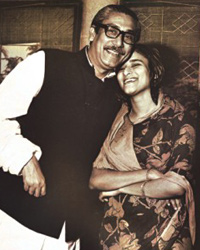 Sheikh Mujibur Rahman (17 Mar 1920 - 15 Aug 1975) 1st President and 2nd Prime Minister of independent Bangladesh. Leader of Awami League. Popularly referred to as 'Bangabandhu' (Friend of Bengal) and 'Jathir Jonok/Pitha' (Father of Nation). Participated in 1952 Bhasha Andolon. Gave the historic 'Ebarer sangram muktir sangram, ebarer sangram swadhinatar sangram' 7 March 1971 speech in Ramna Racecourse (now Suhrawardy Udyan) to inspire a nation to fight for their right. Imprisoned in (West) Pakistani jail for nine-and-half month during Mukhtijuddho. First Constitution of Bangladesh formulated under his leadership. Won Bangladesh's first general election. Creator of the controversial BAKSAL one-party ruling system. Assassinated along with most of his family by rebel officers on 15 August 1975 at family home in Dhanmondi, Dhaka. Daughter Hasina has become PM of Bangladesh on many occassions. Born and buried in Tangail, Dhaka bibhag.
Sheikh Mujibur Rahman (17 Mar 1920 - 15 Aug 1975) 1st President and 2nd Prime Minister of independent Bangladesh. Leader of Awami League. Popularly referred to as 'Bangabandhu' (Friend of Bengal) and 'Jathir Jonok/Pitha' (Father of Nation). Participated in 1952 Bhasha Andolon. Gave the historic 'Ebarer sangram muktir sangram, ebarer sangram swadhinatar sangram' 7 March 1971 speech in Ramna Racecourse (now Suhrawardy Udyan) to inspire a nation to fight for their right. Imprisoned in (West) Pakistani jail for nine-and-half month during Mukhtijuddho. First Constitution of Bangladesh formulated under his leadership. Won Bangladesh's first general election. Creator of the controversial BAKSAL one-party ruling system. Assassinated along with most of his family by rebel officers on 15 August 1975 at family home in Dhanmondi, Dhaka. Daughter Hasina has become PM of Bangladesh on many occassions. Born and buried in Tangail, Dhaka bibhag.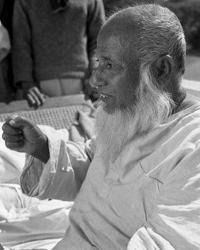 Maulana Abdul Hamid Khan Bhashani (12 Dec 1880 - 17 Nov 1976) Eminent political leader and founder of Awami League (AL) and National Awami Party (NAP).
Maulana Abdul Hamid Khan Bhashani (12 Dec 1880 - 17 Nov 1976) Eminent political leader and founder of Awami League (AL) and National Awami Party (NAP). 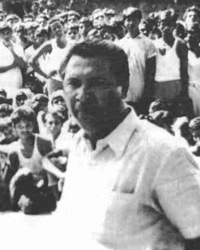 Tajuddin Ahmad (23 July 1925 - 3 Nov 1975) First Prime Minister of Bangladesh.
Tajuddin Ahmad (23 July 1925 - 3 Nov 1975) First Prime Minister of Bangladesh.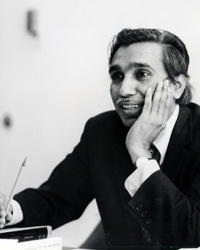 Fazlur Rahman Khan (3 Apr 1929 – 27 Mar 1982) Bangladeshi-American structural engineer and architect. Considered the Father of tubular designs for high-rises. Designed Willis Tower – the 2nd tallest building in the United States (and tallest in the world for many years) - John Hancock Centre (a 100-story tall building), and Hajj Terminal of King Abdulaziz International Airport, Saudi Arabia.
Fazlur Rahman Khan (3 Apr 1929 – 27 Mar 1982) Bangladeshi-American structural engineer and architect. Considered the Father of tubular designs for high-rises. Designed Willis Tower – the 2nd tallest building in the United States (and tallest in the world for many years) - John Hancock Centre (a 100-story tall building), and Hajj Terminal of King Abdulaziz International Airport, Saudi Arabia.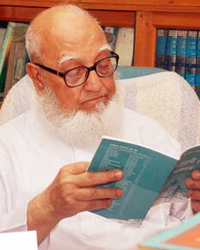 Golam Azam (Born 7 Nov 1922) Ameer of Jamaat-e-Islami Bangladesh until 2000. Bhasha Shoinik (Language Activist) during 1952 Bhasha Andolon. Found guilty in 2013 for alleged war crimes during 1971 Muktijuddho.
Golam Azam (Born 7 Nov 1922) Ameer of Jamaat-e-Islami Bangladesh until 2000. Bhasha Shoinik (Language Activist) during 1952 Bhasha Andolon. Found guilty in 2013 for alleged war crimes during 1971 Muktijuddho. 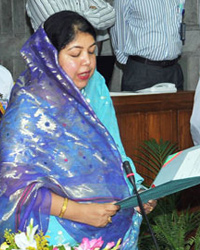 Shirin Sharmin Chaudhury (Born 6 Oct 1966) First female Speaker of Jatiyo Sangshad (National Parliament). Commenced April 2013, and at 46 years of age, she is the youngest to assume the office.
Shirin Sharmin Chaudhury (Born 6 Oct 1966) First female Speaker of Jatiyo Sangshad (National Parliament). Commenced April 2013, and at 46 years of age, she is the youngest to assume the office.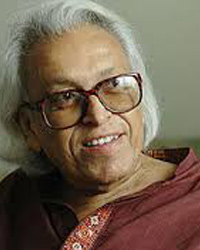 Shamsur Rahman (23 Oct 1929 - 17 Aug 2006) Bengali poet, columnist and journalist. Unofficial poet laureate of Bangladesh. Wrote more than 60 books of poetry.
Shamsur Rahman (23 Oct 1929 - 17 Aug 2006) Bengali poet, columnist and journalist. Unofficial poet laureate of Bangladesh. Wrote more than 60 books of poetry.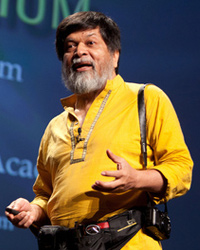 Shahidul Alam (Born 1955) Renowned photographer. Founder of Drik picture library (1989), Pathshala: South Asian Institute of Photography (1998) and a director of Chobi Mela, the festival of photography in Asia.
Shahidul Alam (Born 1955) Renowned photographer. Founder of Drik picture library (1989), Pathshala: South Asian Institute of Photography (1998) and a director of Chobi Mela, the festival of photography in Asia. A. A. M. S. Arefin Siddique (Born 26 Oct 1953)Vice Chancellor of Dhaka University since 15 January 2009. Former professor of Department of Mass Communication and Journalism at DU.
A. A. M. S. Arefin Siddique (Born 26 Oct 1953)Vice Chancellor of Dhaka University since 15 January 2009. Former professor of Department of Mass Communication and Journalism at DU.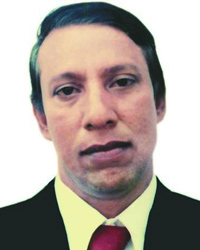 Abdul Malek Chunnu (1958 - 9 May 2013) Legendary hockey player, national coach and national award winning sportsperson.
Abdul Malek Chunnu (1958 - 9 May 2013) Legendary hockey player, national coach and national award winning sportsperson.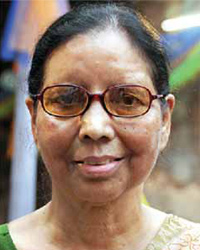 Siddiqua Kabir (7 May 1931 - 31 Jan 2012) Bengali nutritionist, academic, cookbook author and cooking show television host. Famously starred in Siddiqua Kabir's Recipe on NTV Bangla.
Siddiqua Kabir (7 May 1931 - 31 Jan 2012) Bengali nutritionist, academic, cookbook author and cooking show television host. Famously starred in Siddiqua Kabir's Recipe on NTV Bangla.
important info, tips, hints... ittadhi
- Dhaka's official website: www.dhakacity.org
- Shah Jalal International Airport telephone:
- Hospital telephone:
- Railway:
- Police Control Room: 639022
- Shops opening hours: 11am - 7pm everyday except Friday when they're closed.
Stay connected.
- Dhaka (Facebook)
- Dhaka - 400 years History in Photographs (Facebook)
- Dhaka City Corporation
- British High Commission in Dhaka
- UNESCO Office in Dhaka
- US Embassy in Dhaka
Londoni is not responsible for the content of external sites.
May Allah bless Dhaka and our People. Ameen.

